ACC8000: Research in Accounting Practice Assignment - USQ
VerifiedAdded on 2023/03/30
|7
|1417
|59
Report
AI Summary
This report provides a detailed analysis of research methodologies used in accounting practice, specifically focusing on mixed methods research designs as applied in the context of audit expectation gaps. It examines two research articles, one by Masoud (2017) utilizing a sequential explanatory method and another by Weal and Saleh (2018) employing a sequential exploratory approach. The report discusses the advantages and disadvantages of using pre-existing questionnaires in research and evaluates the participant selection process and data analysis techniques used in the studies. Furthermore, it critiques the presentation of findings from interviews and suggests improvements for qualitative data analysis. The report also compares the rigor of quantitative data analysis in both studies, highlighting the use of statistical methods such as Cronbach's coefficient alpha. The student assignment is available on Desklib, a platform offering a wide range of study resources, including past papers and solved assignments, to support students' academic success.
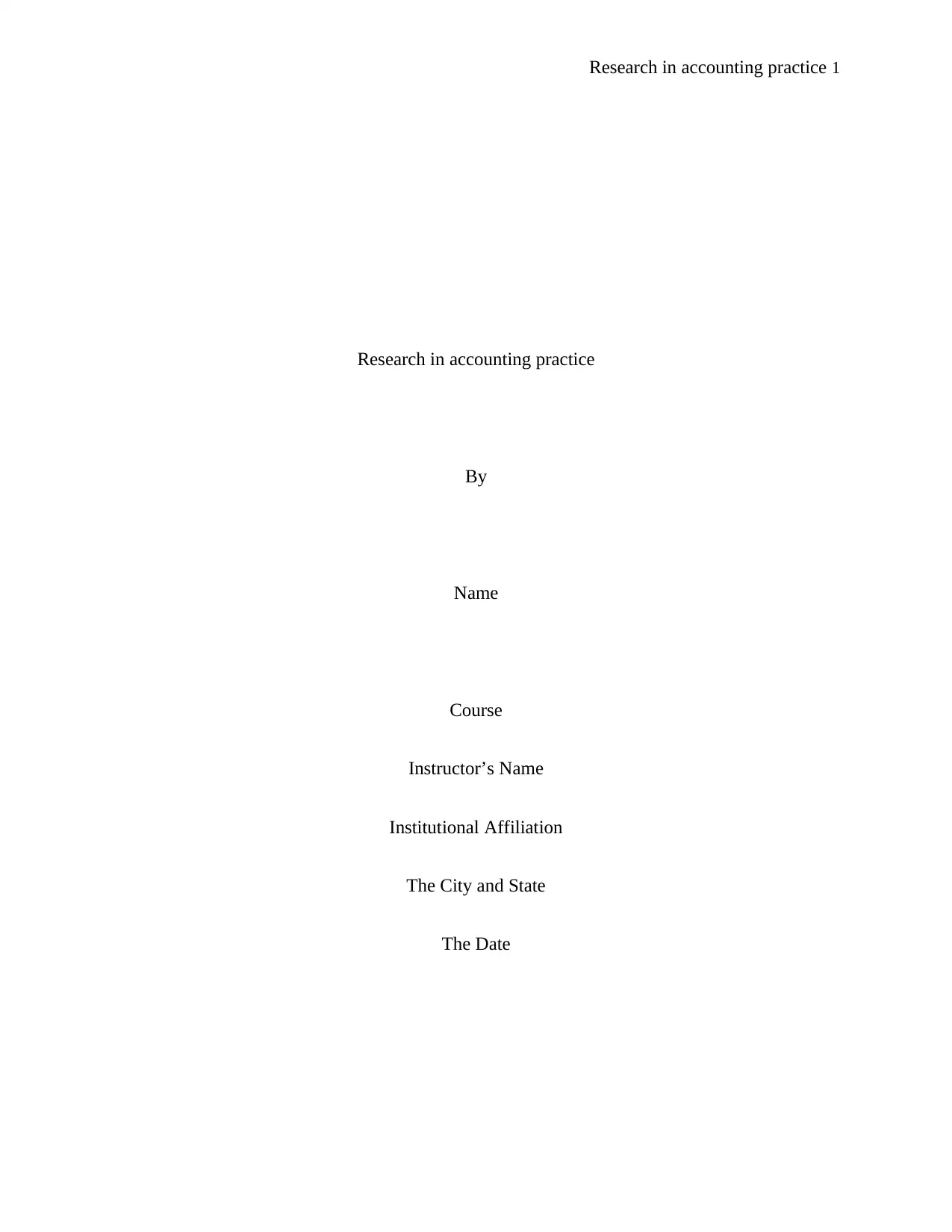
Research in accounting practice 1
Research in accounting practice
By
Name
Course
Instructor’s Name
Institutional Affiliation
The City and State
The Date
Research in accounting practice
By
Name
Course
Instructor’s Name
Institutional Affiliation
The City and State
The Date
Paraphrase This Document
Need a fresh take? Get an instant paraphrase of this document with our AI Paraphraser
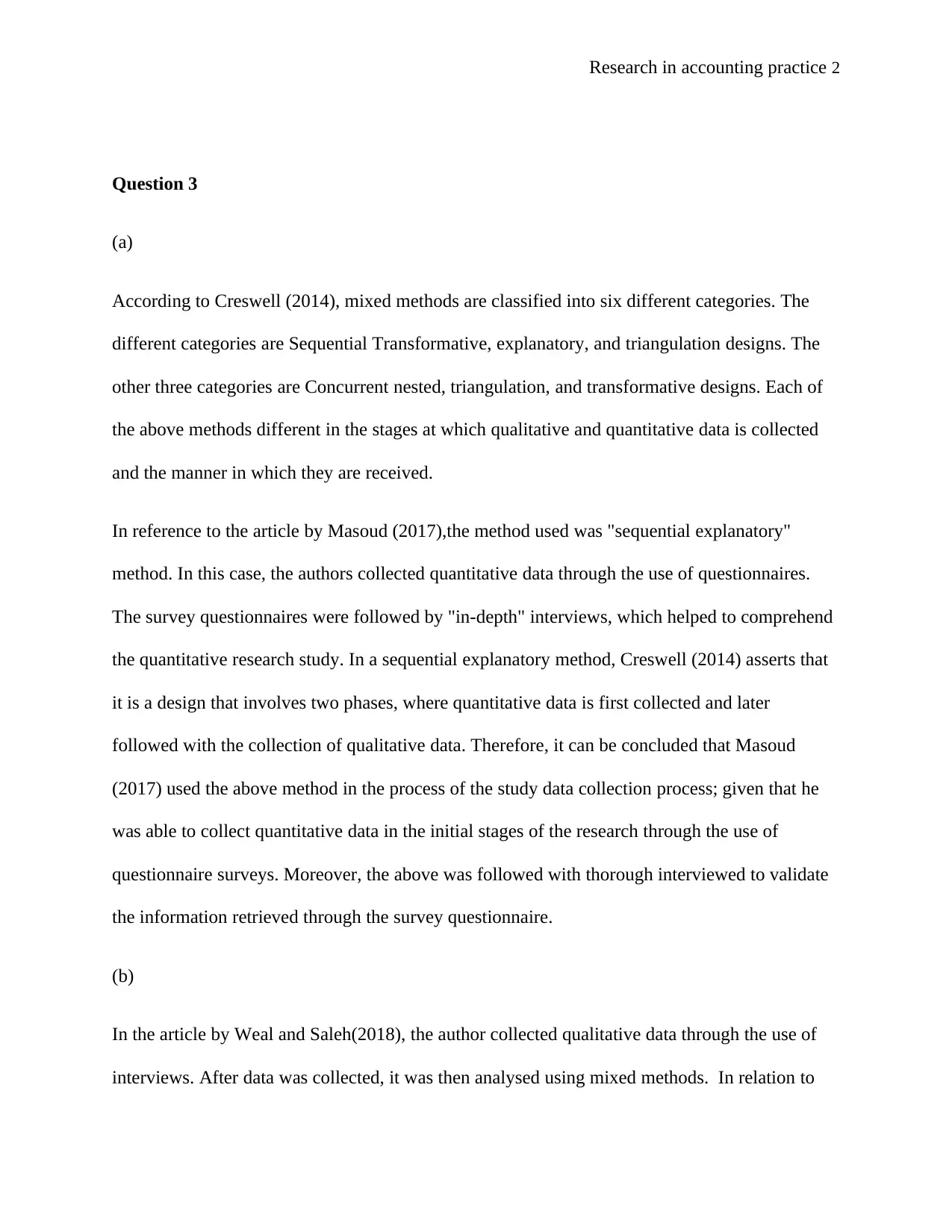
Research in accounting practice 2
Question 3
(a)
According to Creswell (2014), mixed methods are classified into six different categories. The
different categories are Sequential Transformative, explanatory, and triangulation designs. The
other three categories are Concurrent nested, triangulation, and transformative designs. Each of
the above methods different in the stages at which qualitative and quantitative data is collected
and the manner in which they are received.
In reference to the article by Masoud (2017),the method used was "sequential explanatory"
method. In this case, the authors collected quantitative data through the use of questionnaires.
The survey questionnaires were followed by "in-depth" interviews, which helped to comprehend
the quantitative research study. In a sequential explanatory method, Creswell (2014) asserts that
it is a design that involves two phases, where quantitative data is first collected and later
followed with the collection of qualitative data. Therefore, it can be concluded that Masoud
(2017) used the above method in the process of the study data collection process; given that he
was able to collect quantitative data in the initial stages of the research through the use of
questionnaire surveys. Moreover, the above was followed with thorough interviewed to validate
the information retrieved through the survey questionnaire.
(b)
In the article by Weal and Saleh(2018), the author collected qualitative data through the use of
interviews. After data was collected, it was then analysed using mixed methods. In relation to
Question 3
(a)
According to Creswell (2014), mixed methods are classified into six different categories. The
different categories are Sequential Transformative, explanatory, and triangulation designs. The
other three categories are Concurrent nested, triangulation, and transformative designs. Each of
the above methods different in the stages at which qualitative and quantitative data is collected
and the manner in which they are received.
In reference to the article by Masoud (2017),the method used was "sequential explanatory"
method. In this case, the authors collected quantitative data through the use of questionnaires.
The survey questionnaires were followed by "in-depth" interviews, which helped to comprehend
the quantitative research study. In a sequential explanatory method, Creswell (2014) asserts that
it is a design that involves two phases, where quantitative data is first collected and later
followed with the collection of qualitative data. Therefore, it can be concluded that Masoud
(2017) used the above method in the process of the study data collection process; given that he
was able to collect quantitative data in the initial stages of the research through the use of
questionnaire surveys. Moreover, the above was followed with thorough interviewed to validate
the information retrieved through the survey questionnaire.
(b)
In the article by Weal and Saleh(2018), the author collected qualitative data through the use of
interviews. After data was collected, it was then analysed using mixed methods. In relation to
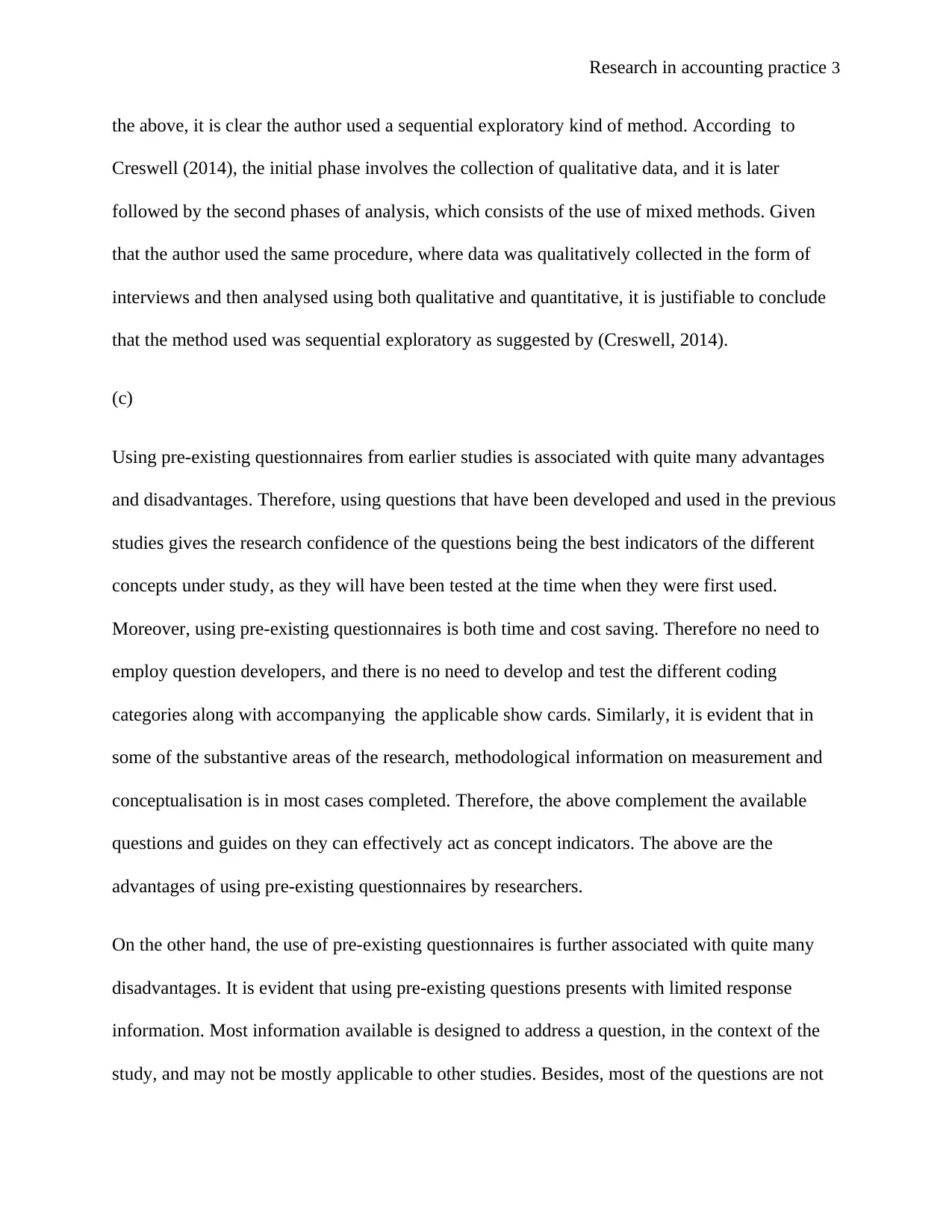
Research in accounting practice 3
the above, it is clear the author used a sequential exploratory kind of method. According to
Creswell (2014), the initial phase involves the collection of qualitative data, and it is later
followed by the second phases of analysis, which consists of the use of mixed methods. Given
that the author used the same procedure, where data was qualitatively collected in the form of
interviews and then analysed using both qualitative and quantitative, it is justifiable to conclude
that the method used was sequential exploratory as suggested by (Creswell, 2014).
(c)
Using pre-existing questionnaires from earlier studies is associated with quite many advantages
and disadvantages. Therefore, using questions that have been developed and used in the previous
studies gives the research confidence of the questions being the best indicators of the different
concepts under study, as they will have been tested at the time when they were first used.
Moreover, using pre-existing questionnaires is both time and cost saving. Therefore no need to
employ question developers, and there is no need to develop and test the different coding
categories along with accompanying the applicable show cards. Similarly, it is evident that in
some of the substantive areas of the research, methodological information on measurement and
conceptualisation is in most cases completed. Therefore, the above complement the available
questions and guides on they can effectively act as concept indicators. The above are the
advantages of using pre-existing questionnaires by researchers.
On the other hand, the use of pre-existing questionnaires is further associated with quite many
disadvantages. It is evident that using pre-existing questions presents with limited response
information. Most information available is designed to address a question, in the context of the
study, and may not be mostly applicable to other studies. Besides, most of the questions are not
the above, it is clear the author used a sequential exploratory kind of method. According to
Creswell (2014), the initial phase involves the collection of qualitative data, and it is later
followed by the second phases of analysis, which consists of the use of mixed methods. Given
that the author used the same procedure, where data was qualitatively collected in the form of
interviews and then analysed using both qualitative and quantitative, it is justifiable to conclude
that the method used was sequential exploratory as suggested by (Creswell, 2014).
(c)
Using pre-existing questionnaires from earlier studies is associated with quite many advantages
and disadvantages. Therefore, using questions that have been developed and used in the previous
studies gives the research confidence of the questions being the best indicators of the different
concepts under study, as they will have been tested at the time when they were first used.
Moreover, using pre-existing questionnaires is both time and cost saving. Therefore no need to
employ question developers, and there is no need to develop and test the different coding
categories along with accompanying the applicable show cards. Similarly, it is evident that in
some of the substantive areas of the research, methodological information on measurement and
conceptualisation is in most cases completed. Therefore, the above complement the available
questions and guides on they can effectively act as concept indicators. The above are the
advantages of using pre-existing questionnaires by researchers.
On the other hand, the use of pre-existing questionnaires is further associated with quite many
disadvantages. It is evident that using pre-existing questions presents with limited response
information. Most information available is designed to address a question, in the context of the
study, and may not be mostly applicable to other studies. Besides, most of the questions are not
⊘ This is a preview!⊘
Do you want full access?
Subscribe today to unlock all pages.

Trusted by 1+ million students worldwide
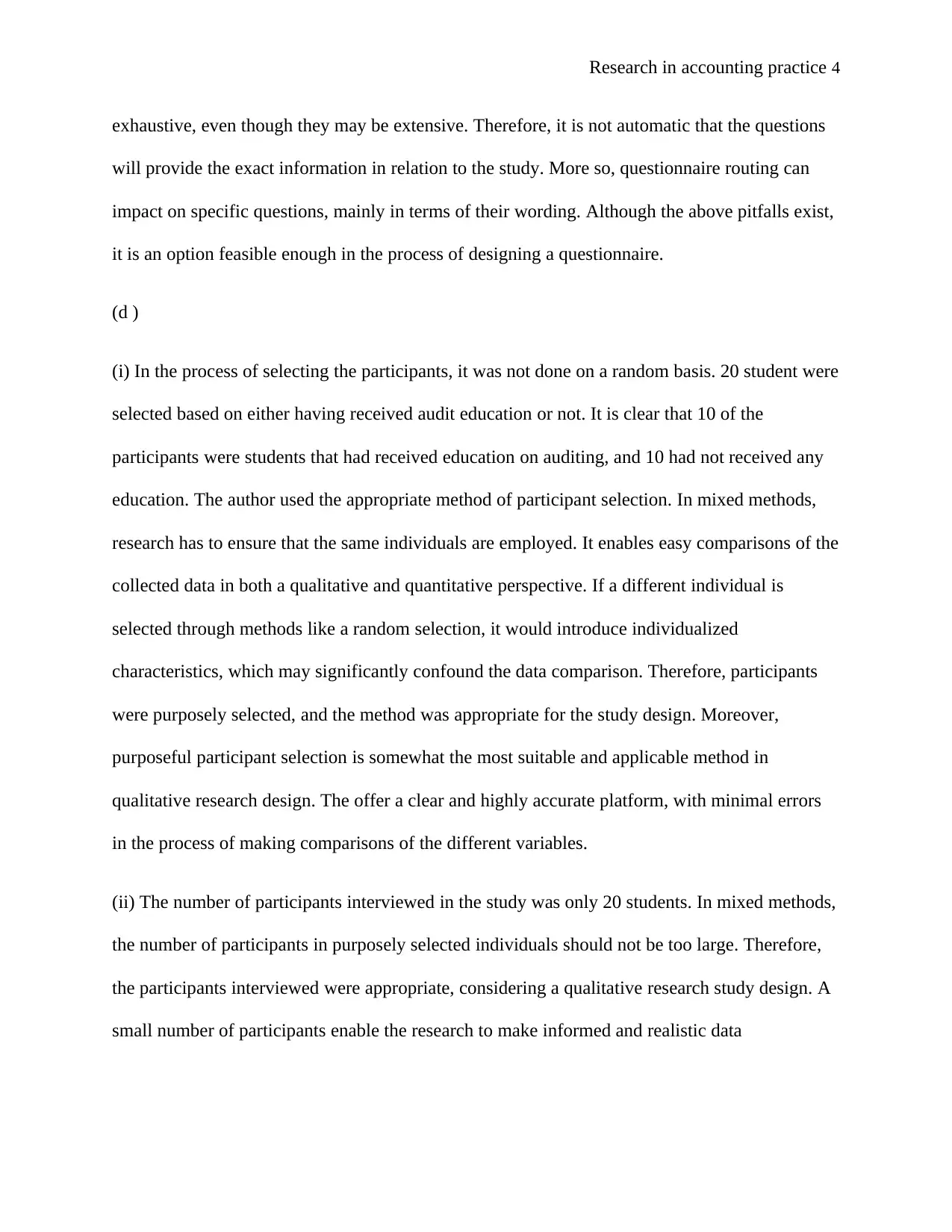
Research in accounting practice 4
exhaustive, even though they may be extensive. Therefore, it is not automatic that the questions
will provide the exact information in relation to the study. More so, questionnaire routing can
impact on specific questions, mainly in terms of their wording. Although the above pitfalls exist,
it is an option feasible enough in the process of designing a questionnaire.
(d )
(i) In the process of selecting the participants, it was not done on a random basis. 20 student were
selected based on either having received audit education or not. It is clear that 10 of the
participants were students that had received education on auditing, and 10 had not received any
education. The author used the appropriate method of participant selection. In mixed methods,
research has to ensure that the same individuals are employed. It enables easy comparisons of the
collected data in both a qualitative and quantitative perspective. If a different individual is
selected through methods like a random selection, it would introduce individualized
characteristics, which may significantly confound the data comparison. Therefore, participants
were purposely selected, and the method was appropriate for the study design. Moreover,
purposeful participant selection is somewhat the most suitable and applicable method in
qualitative research design. The offer a clear and highly accurate platform, with minimal errors
in the process of making comparisons of the different variables.
(ii) The number of participants interviewed in the study was only 20 students. In mixed methods,
the number of participants in purposely selected individuals should not be too large. Therefore,
the participants interviewed were appropriate, considering a qualitative research study design. A
small number of participants enable the research to make informed and realistic data
exhaustive, even though they may be extensive. Therefore, it is not automatic that the questions
will provide the exact information in relation to the study. More so, questionnaire routing can
impact on specific questions, mainly in terms of their wording. Although the above pitfalls exist,
it is an option feasible enough in the process of designing a questionnaire.
(d )
(i) In the process of selecting the participants, it was not done on a random basis. 20 student were
selected based on either having received audit education or not. It is clear that 10 of the
participants were students that had received education on auditing, and 10 had not received any
education. The author used the appropriate method of participant selection. In mixed methods,
research has to ensure that the same individuals are employed. It enables easy comparisons of the
collected data in both a qualitative and quantitative perspective. If a different individual is
selected through methods like a random selection, it would introduce individualized
characteristics, which may significantly confound the data comparison. Therefore, participants
were purposely selected, and the method was appropriate for the study design. Moreover,
purposeful participant selection is somewhat the most suitable and applicable method in
qualitative research design. The offer a clear and highly accurate platform, with minimal errors
in the process of making comparisons of the different variables.
(ii) The number of participants interviewed in the study was only 20 students. In mixed methods,
the number of participants in purposely selected individuals should not be too large. Therefore,
the participants interviewed were appropriate, considering a qualitative research study design. A
small number of participants enable the research to make informed and realistic data
Paraphrase This Document
Need a fresh take? Get an instant paraphrase of this document with our AI Paraphraser
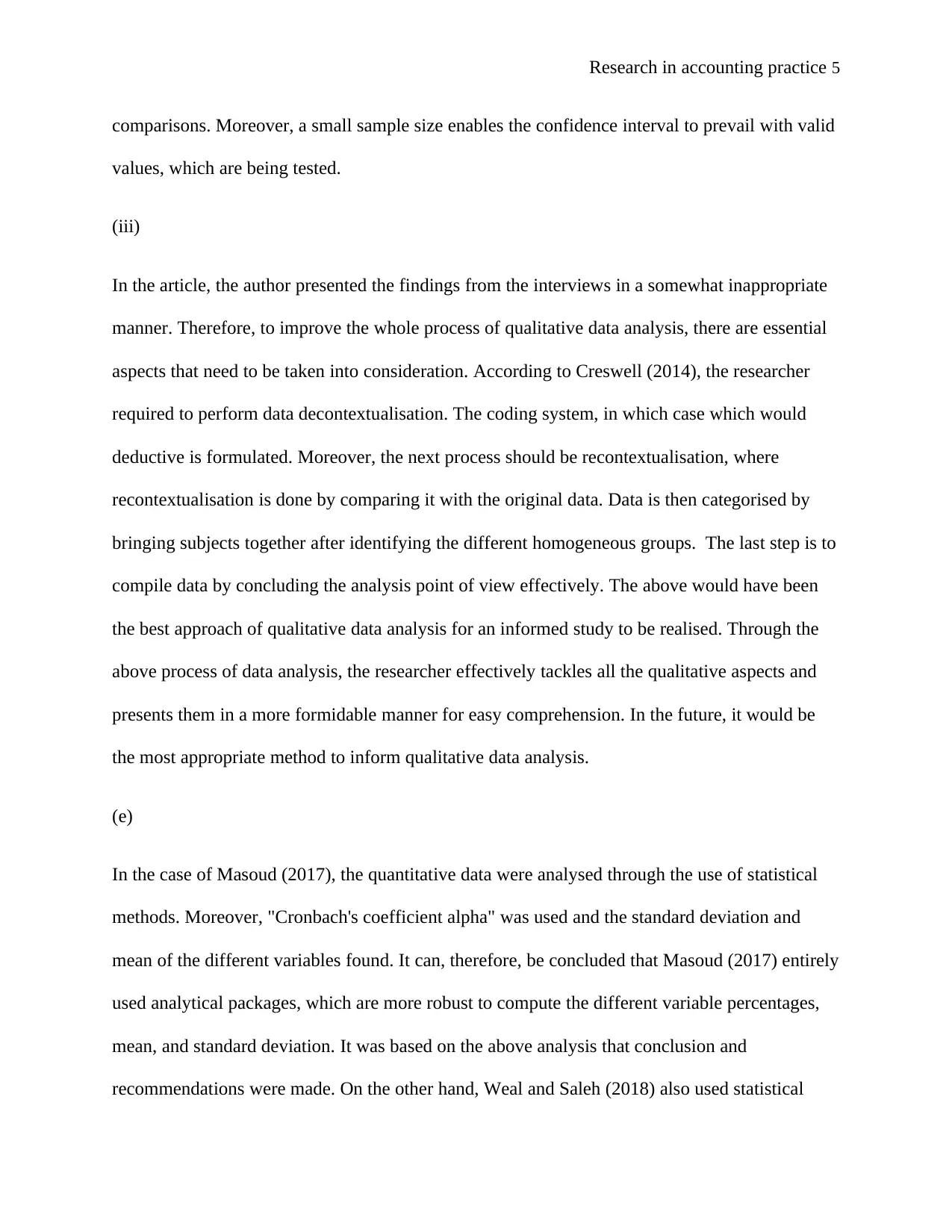
Research in accounting practice 5
comparisons. Moreover, a small sample size enables the confidence interval to prevail with valid
values, which are being tested.
(iii)
In the article, the author presented the findings from the interviews in a somewhat inappropriate
manner. Therefore, to improve the whole process of qualitative data analysis, there are essential
aspects that need to be taken into consideration. According to Creswell (2014), the researcher
required to perform data decontextualisation. The coding system, in which case which would
deductive is formulated. Moreover, the next process should be recontextualisation, where
recontextualisation is done by comparing it with the original data. Data is then categorised by
bringing subjects together after identifying the different homogeneous groups. The last step is to
compile data by concluding the analysis point of view effectively. The above would have been
the best approach of qualitative data analysis for an informed study to be realised. Through the
above process of data analysis, the researcher effectively tackles all the qualitative aspects and
presents them in a more formidable manner for easy comprehension. In the future, it would be
the most appropriate method to inform qualitative data analysis.
(e)
In the case of Masoud (2017), the quantitative data were analysed through the use of statistical
methods. Moreover, "Cronbach's coefficient alpha" was used and the standard deviation and
mean of the different variables found. It can, therefore, be concluded that Masoud (2017) entirely
used analytical packages, which are more robust to compute the different variable percentages,
mean, and standard deviation. It was based on the above analysis that conclusion and
recommendations were made. On the other hand, Weal and Saleh (2018) also used statistical
comparisons. Moreover, a small sample size enables the confidence interval to prevail with valid
values, which are being tested.
(iii)
In the article, the author presented the findings from the interviews in a somewhat inappropriate
manner. Therefore, to improve the whole process of qualitative data analysis, there are essential
aspects that need to be taken into consideration. According to Creswell (2014), the researcher
required to perform data decontextualisation. The coding system, in which case which would
deductive is formulated. Moreover, the next process should be recontextualisation, where
recontextualisation is done by comparing it with the original data. Data is then categorised by
bringing subjects together after identifying the different homogeneous groups. The last step is to
compile data by concluding the analysis point of view effectively. The above would have been
the best approach of qualitative data analysis for an informed study to be realised. Through the
above process of data analysis, the researcher effectively tackles all the qualitative aspects and
presents them in a more formidable manner for easy comprehension. In the future, it would be
the most appropriate method to inform qualitative data analysis.
(e)
In the case of Masoud (2017), the quantitative data were analysed through the use of statistical
methods. Moreover, "Cronbach's coefficient alpha" was used and the standard deviation and
mean of the different variables found. It can, therefore, be concluded that Masoud (2017) entirely
used analytical packages, which are more robust to compute the different variable percentages,
mean, and standard deviation. It was based on the above analysis that conclusion and
recommendations were made. On the other hand, Weal and Saleh (2018) also used statistical
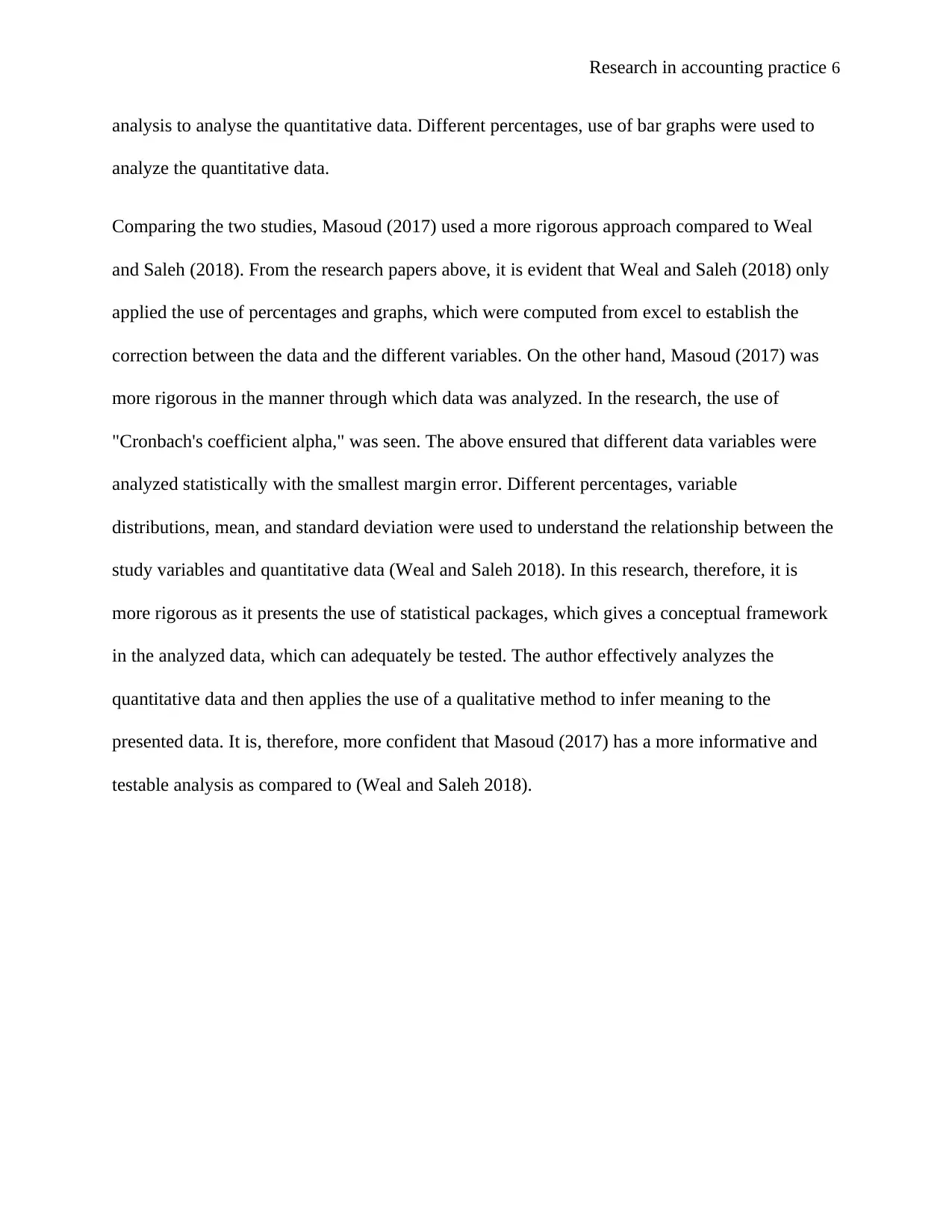
Research in accounting practice 6
analysis to analyse the quantitative data. Different percentages, use of bar graphs were used to
analyze the quantitative data.
Comparing the two studies, Masoud (2017) used a more rigorous approach compared to Weal
and Saleh (2018). From the research papers above, it is evident that Weal and Saleh (2018) only
applied the use of percentages and graphs, which were computed from excel to establish the
correction between the data and the different variables. On the other hand, Masoud (2017) was
more rigorous in the manner through which data was analyzed. In the research, the use of
"Cronbach's coefficient alpha," was seen. The above ensured that different data variables were
analyzed statistically with the smallest margin error. Different percentages, variable
distributions, mean, and standard deviation were used to understand the relationship between the
study variables and quantitative data (Weal and Saleh 2018). In this research, therefore, it is
more rigorous as it presents the use of statistical packages, which gives a conceptual framework
in the analyzed data, which can adequately be tested. The author effectively analyzes the
quantitative data and then applies the use of a qualitative method to infer meaning to the
presented data. It is, therefore, more confident that Masoud (2017) has a more informative and
testable analysis as compared to (Weal and Saleh 2018).
analysis to analyse the quantitative data. Different percentages, use of bar graphs were used to
analyze the quantitative data.
Comparing the two studies, Masoud (2017) used a more rigorous approach compared to Weal
and Saleh (2018). From the research papers above, it is evident that Weal and Saleh (2018) only
applied the use of percentages and graphs, which were computed from excel to establish the
correction between the data and the different variables. On the other hand, Masoud (2017) was
more rigorous in the manner through which data was analyzed. In the research, the use of
"Cronbach's coefficient alpha," was seen. The above ensured that different data variables were
analyzed statistically with the smallest margin error. Different percentages, variable
distributions, mean, and standard deviation were used to understand the relationship between the
study variables and quantitative data (Weal and Saleh 2018). In this research, therefore, it is
more rigorous as it presents the use of statistical packages, which gives a conceptual framework
in the analyzed data, which can adequately be tested. The author effectively analyzes the
quantitative data and then applies the use of a qualitative method to infer meaning to the
presented data. It is, therefore, more confident that Masoud (2017) has a more informative and
testable analysis as compared to (Weal and Saleh 2018).
⊘ This is a preview!⊘
Do you want full access?
Subscribe today to unlock all pages.

Trusted by 1+ million students worldwide
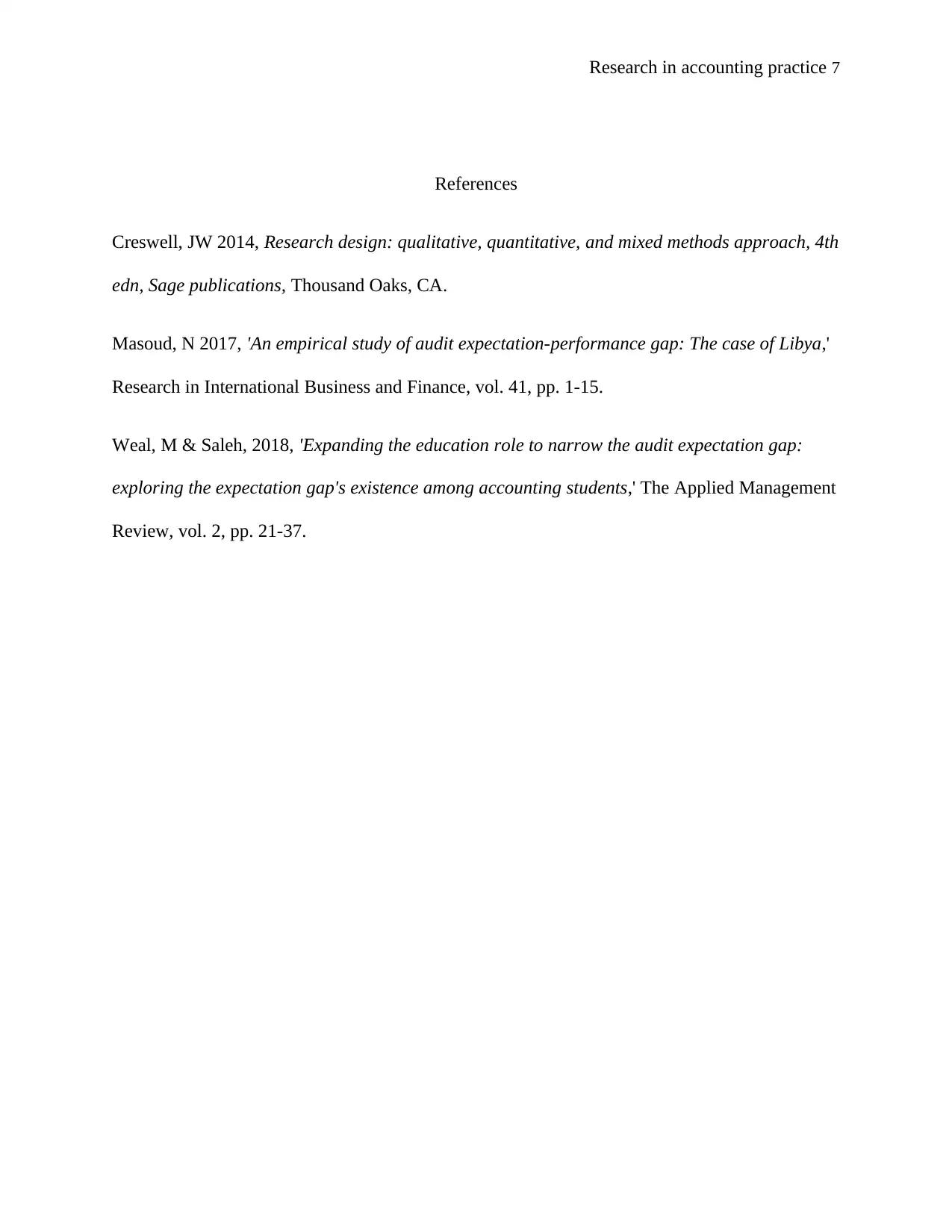
Research in accounting practice 7
References
Creswell, JW 2014, Research design: qualitative, quantitative, and mixed methods approach, 4th
edn, Sage publications, Thousand Oaks, CA.
Masoud, N 2017, 'An empirical study of audit expectation-performance gap: The case of Libya,'
Research in International Business and Finance, vol. 41, pp. 1-15.
Weal, M & Saleh, 2018, 'Expanding the education role to narrow the audit expectation gap:
exploring the expectation gap's existence among accounting students,' The Applied Management
Review, vol. 2, pp. 21-37.
References
Creswell, JW 2014, Research design: qualitative, quantitative, and mixed methods approach, 4th
edn, Sage publications, Thousand Oaks, CA.
Masoud, N 2017, 'An empirical study of audit expectation-performance gap: The case of Libya,'
Research in International Business and Finance, vol. 41, pp. 1-15.
Weal, M & Saleh, 2018, 'Expanding the education role to narrow the audit expectation gap:
exploring the expectation gap's existence among accounting students,' The Applied Management
Review, vol. 2, pp. 21-37.
1 out of 7
Related Documents
Your All-in-One AI-Powered Toolkit for Academic Success.
+13062052269
info@desklib.com
Available 24*7 on WhatsApp / Email
![[object Object]](/_next/static/media/star-bottom.7253800d.svg)
Unlock your academic potential
Copyright © 2020–2025 A2Z Services. All Rights Reserved. Developed and managed by ZUCOL.





